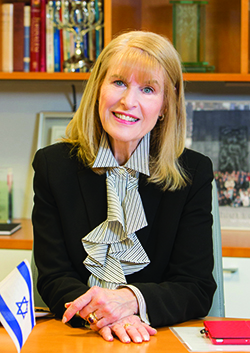Hadassah
President's Column
The Adar-Nisan Nexus

In an era of unrelenting change, some may feel that our 2,500-year-old Scripture is irrelevant to the modern world. I believe the Hebrew Bible’s very constancy makes it invaluable as a lens through which we make sense of what is happening around us.
Biblical scholars, for example, have long debated the relationship between Purim and Passover, separated by 31 days, but on one point they are unanimous—the proximity is not accidental. Indeed, when a Hebrew calendar leap year requires an Adar I and Adar II, as it does this year, Purim is assigned to the second cycle, to preserve its nearness to Pesach.
The balance between the two holidays has evolved over time. Purim, which begins this year the evening of March 20, is the Diaspora model of Jews as a minority community. Pesach, which begins the evening of April 19, is our liberation story, starting with slavery and preparing us for national sovereignty.
Our ancestors always understood the distinct lessons of the respective holidays, but my focus here is the dominant Jewish narrative of every age. From the destruction of the Second Temple until the birth of Zionism, Diaspora defined Jewish existence; the Passover story, recited every year, was more aspiration
than preparation.
The paradigm shifted in the early Zionist era through the Holocaust and into Israel’s nascent years as a nation, when the Pesach model became increasingly, starkly relevant to the Jewish future. Zionism provided not just the dream but also the reality that gave any threatened Diaspora community an exit strategy. Purim/Diaspora and Pesach/Israel reached a point where they were no longer in separate orbits but facets of the same gravitational force.
By the 1990s, the overwhelming majority of world Jewry was living in the sovereign Jewish state or other democratic nations. Israel’s economy was booming and the term “peace process” seemed more hopeful than ironic. Some might have argued that the Purim/Diaspora dimension of our story was receding.
This apparent stability didn’t last. Nearly 20 years into the new century, the shocking emergence of extremism in free societies—from Great Britain and France to the United States—is challenging the existing order as well as Jewish life. For nearly two years, from the hateful chants in Charlottesville to the deadly Pittsburgh synagogue attack, our sense of integration into society’s fabric has been shaken.
Purim’s lesson stands: The only way to assert our rights to speak out and to defend ourselves in the Diaspora is by exercising them. The best way to be an integral part of society is to participate and to advocate—for ourselves and for the common good.
Hadassah got it right: Purim and Pesach are like two parts of the same heart. We took our name from Queen Esther of the Purim story—who saved her people—and our mission from the Zionist dream of rebuilding Israel. Our goals are a resilient Jewish state and a free American Jewish community, both emphasizing the values and causes we hold dear.
In America, Hadassah advocates for women’s rights, health equity, combating anti-Semitism and other forms of hate as well as supports strong American-Israeli ties. We recently opened a new government relations office in Washington, D.C., to energize our legislative and grassroots mobilization strategies and give us a more robust presence in the nation’s capital.
As times change, sometimes one or the other side of our Purim-Pesach identity calls for more attention. Many of us are troubled by the growing alienation of American Jews from Israel. Part of Hadassah’s job is to promote both unity and the free exchange of ideas, so that all Jews feel comfortable engaging with the Jewish state, even if—perhaps especially if—they don’t embrace every action of its government.
Hadassah teaches us to look forward, and one of the best guides for the future is looking at the path we have traveled from the beginning, informed and inspired by our values and history.
A happy Purim season and a wonderful Pesach to all.










 Facebook
Facebook Instagram
Instagram Twitter
Twitter
Leave a Reply